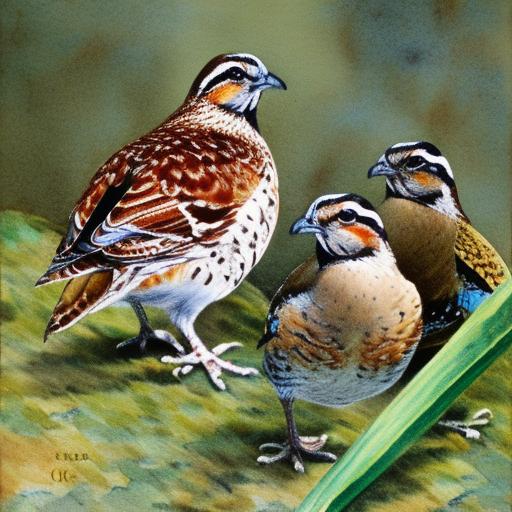Quail farming has been gaining popularity in the Philippines due to the high demand for quail eggs and meat. Quails are small, ground-dwelling birds that are known for their fast growth and high egg production. There are several quail breeds that are raised in the Philippines, each with its own unique characteristics and traits. These breeds are bred for different purposes, such as meat production, egg production, or ornamental purposes. Quail farming is a lucrative business in the Philippines, and many farmers are turning to quail farming as a way to supplement their income.
Quail farming is relatively easy and inexpensive compared to other types of poultry farming, making it an attractive option for small-scale farmers. Quails are also known for their ability to adapt to different environments, making them suitable for farming in various regions of the Philippines. In addition, quails reach maturity quickly and have a high reproductive rate, allowing farmers to quickly build up their flocks and increase their production. With the increasing demand for quail products in the Philippines, it is important for farmers to understand the different quail breeds available and their specific characteristics and traits in order to make informed decisions about which breeds to raise.
Key Takeaways
- Quail breeding is a popular practice in the Philippines, with various breeds being raised for their meat and eggs.
- Popular quail breeds in the Philippines include the Japanese quail, the Bobwhite quail, and the Button quail.
- Different quail breeds have unique characteristics and traits, such as size, color, and egg production.
- Advantages of raising quail breeds include their fast growth and high egg production, while disadvantages may include specific dietary needs and susceptibility to certain diseases.
- Breeding and rearing practices for different quail breeds involve providing proper housing, nutrition, and disease management to ensure healthy growth and reproduction.
Popular Quail Breeds in the Philippines
There are several popular quail breeds that are raised in the Philippines, each with its own unique characteristics and traits. One of the most popular quail breeds in the Philippines is the Japanese quail, also known as the Coturnix quail. Japanese quails are known for their high egg production, with some hens laying up to 300 eggs per year. They are also valued for their fast growth and high meat quality, making them a popular choice for meat production. Another popular quail breed in the Philippines is the Bobwhite quail, which is native to North America but has been successfully introduced to the Philippines. Bobwhite quails are known for their distinctive call and are often raised for their ornamental value as well as for meat and egg production.
In addition to Japanese and Bobwhite quails, other popular quail breeds in the Philippines include the Pharaoh quail, Tuxedo quail, and Texas A&M quail. Each of these breeds has its own unique characteristics and traits that make them suitable for different purposes, such as meat production, egg production, or ornamental purposes. It is important for farmers to carefully consider the specific traits of each breed in order to determine which breed is best suited to their farming goals and resources.
Characteristics and Traits of Different Quail Breeds
Each quail breed has its own unique characteristics and traits that make it suitable for different purposes. Japanese quails, for example, are known for their high egg production, with some hens laying up to 300 eggs per year. They are also valued for their fast growth and high meat quality, making them a popular choice for meat production. Japanese quails come in a variety of colors, including brown, white, and tuxedo, making them an attractive option for farmers who are interested in raising ornamental quails.
Bobwhite quails, on the other hand, are known for their distinctive call and are often raised for their ornamental value as well as for meat and egg production. They are smaller in size compared to Japanese quails and come in different color variations, including white, brown, and speckled. Bobwhite quails are also known for their ability to adapt to different environments, making them suitable for farming in various regions of the Philippines.
Pharaoh quails are another popular breed in the Philippines, known for their high egg production and fast growth. They are larger in size compared to Japanese and Bobwhite quails and come in a variety of colors, including brown and white. Tuxedo quails are valued for their unique coloration, with black and white feathers that give them a distinctive appearance. Texas A&M quails are known for their high egg production and fast growth, making them a popular choice for commercial quail farming.
Advantages and Disadvantages of Raising Different Quail Breeds
Each quail breed has its own set of advantages and disadvantages that farmers should consider when deciding which breed to raise. Japanese quails are valued for their high egg production and fast growth, making them a popular choice for commercial quail farming. However, they can be more sensitive to stress compared to other breeds, requiring careful management to ensure optimal production.
Bobwhite quails are known for their distinctive call and ornamental value, making them a popular choice for farmers who are interested in raising quails for non-commercial purposes. However, they have lower egg production compared to Japanese quails, making them less suitable for commercial egg production.
Pharaoh quails are valued for their high egg production and fast growth, making them a popular choice for commercial quail farming. However, they can be more aggressive compared to other breeds, requiring careful management to prevent fighting and injuries.
Tuxedo quails are valued for their unique coloration and ornamental value, making them a popular choice for farmers who are interested in raising ornamental quails. However, they have lower egg production compared to other breeds, making them less suitable for commercial egg production.
Texas A&M quails are known for their high egg production and fast growth, making them a popular choice for commercial quail farming. However, they can be more sensitive to heat stress compared to other breeds, requiring careful management during hot weather.
Breeding and Rearing Practices for Different Quail Breeds
Breeding and rearing practices can vary depending on the specific characteristics and traits of each quail breed. Japanese quails are typically raised in large commercial operations where they are housed in climate-controlled facilities to optimize egg production. They require careful management of lighting, temperature, and nutrition to ensure optimal egg production.
Bobwhite quails are often raised in smaller-scale operations where they are provided with outdoor access to mimic their natural habitat. They require careful management of housing and predator protection to ensure their safety and well-being.
Pharaoh quails are typically raised in large commercial operations similar to Japanese quails, requiring careful management of lighting, temperature, and nutrition to optimize egg production.
Tuxedo quails are often raised in smaller-scale operations where they are provided with outdoor access to mimic their natural habitat. They require careful management of housing and predator protection to ensure their safety and well-being.
Texas A&M quails are typically raised in large commercial operations similar to Japanese quails, requiring careful management of lighting, temperature, and nutrition to optimize egg production.
Economic Importance of Quail Breeds in the Philippines

Quail farming plays an important role in the economy of the Philippines, providing a source of income for many small-scale farmers. The high demand for quail eggs and meat has created opportunities for farmers to capitalize on this market by raising different quail breeds suited to their specific goals and resources.
Quail farming also provides employment opportunities in rural areas where many small-scale farmers rely on quail farming as a source of income. In addition, the sale of quail eggs and meat contributes to the local economy by providing affordable sources of protein for consumers.
The economic importance of quail farming has also led to advancements in breeding and rearing practices aimed at improving productivity and profitability. As a result, many farmers have been able to increase their income by raising different quail breeds suited to the demands of the market.
Conservation Efforts for Native Quail Breeds in the Philippines
Conservation efforts for native quail breeds in the Philippines have become increasingly important as the demand for commercial quail breeds continues to grow. Native quail breeds such as the Philippine Quail (Excalfactoria chinensis) are at risk of decline due to habitat loss and hunting pressure.
Conservation efforts aim to protect native quail breeds by preserving their natural habitats and implementing sustainable hunting practices. In addition, captive breeding programs have been established to maintain genetic diversity and prevent the decline of native quail populations.
The conservation of native quail breeds is important not only for preserving biodiversity but also for maintaining cultural traditions associated with hunting and wildlife appreciation. By protecting native quail breeds, conservation efforts contribute to the overall health of ecosystems while providing opportunities for sustainable use by local communities.
If you’re interested in learning more about the different breeds of quail in the Philippines, you might also want to check out this informative article on creating the perfect chicken coop and nest box at PoultryWizard. Understanding the best practices for housing and nesting can be beneficial for both chickens and quails, ensuring their comfort and well-being.
FAQs
What are the common breeds of quail in the Philippines?
The common breeds of quail in the Philippines include the Japanese quail (Coturnix japonica) and the King quail (Excalfactoria chinensis). These breeds are popular for their meat and egg production.
What are the characteristics of Japanese quail?
Japanese quail are known for their fast growth, early maturity, and high egg production. They are also adaptable to various environmental conditions and are relatively easy to raise.
What are the characteristics of King quail?
King quail, also known as button quail, are smaller in size compared to Japanese quail. They are known for their colorful plumage and are often kept for ornamental purposes. They are also known for their gentle nature and are relatively easy to care for.
What are the uses of quail in the Philippines?
Quail in the Philippines are primarily raised for their meat and eggs. Quail meat is considered a delicacy and is known for its tender texture and rich flavor. Quail eggs are also popular for their nutritional value and are often used in various culinary dishes.
What are the common challenges in raising quail in the Philippines?
Common challenges in raising quail in the Philippines include proper housing and management, disease prevention, and market access for quail products. Additionally, ensuring proper nutrition and adequate water supply are also important factors in successful quail farming.
Meet Walter, the feathered-friend fanatic of Florida! Nestled in the sunshine state, Walter struts through life with his feathered companions, clucking his way to happiness. With a coop that’s fancier than a five-star hotel, he’s the Don Juan of the chicken world. When he’s not teaching his hens to do the cha-cha, you’ll find him in a heated debate with his prized rooster, Sir Clucks-a-Lot. Walter’s poultry passion is no yolk; he’s the sunny-side-up guy you never knew you needed in your flock of friends!







